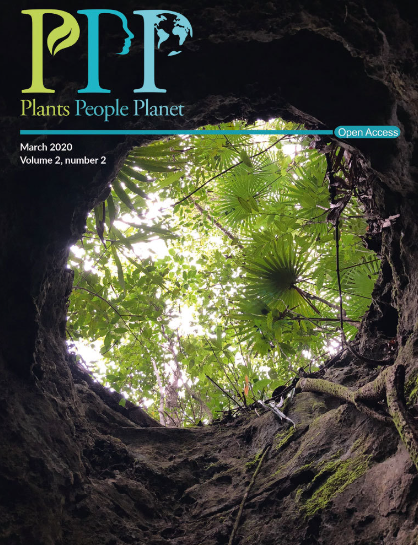单纯Loudetia simplex的遗传变异支持了马达加斯加古代草原的存在
IF 3.6
2区 环境科学与生态学
Q1 BIODIVERSITY CONSERVATION
引用次数: 0
摘要
社会影响声明承认在人类殖民之前,以Loudetia为主导的草原是广泛存在的,这突出了开放的生态系统是并且将继续是马达加斯加生物多样性的重要组成部分。更好地了解构成草原生态系统的植物物种对于支持生计的有效土地管理战略是必要的,但使用当代基因组工具实施保护性遗传研究存在巨大的财政和后勤障碍。缺乏参考基因组的非模型多倍体群体遗传分析的一些挑战可以通过开发计算资源来改善,这些计算资源利用成本效益高的数据生成策略,不需要事先了解目标物种的遗传知识。与目前的微卫星分析相比,这可能有利于低运营预算的保护项目,同时减少不确定性。在人类殖民之前,马达加斯加草原的范围尚未得到解决。我们使用了广泛优势的c4火适应草(Loudetia simplex)的群体遗传分析,作为估计草地随时间变化的代理。我们仔细检查了目标富集数据在群体遗传学中的效用,从而为保护遗传学提出建议。我们探索了从目标富集数据估计个体倍性水平的潜力,以及关于倍性的假设如何影响分析。我们开发了一种新的生物信息学管道,从目标富集数据中估计倍性和基因型。除了树种树和种群结构外,我们还估计了标准种群遗传汇总统计。扩展贝叶斯天际线图为经验和模拟数据提供了随时间变化的人口规模估计。本研究取样的所有马达加斯加单孢松属个体均形成一个分支,可能表明其祖先分布在海拔800 m及以上的中央高原。人口统计学模型表明,草原扩张发生在末次间冰期之前,并支持人类殖民之前的广阔草原。尽管在群体遗传研究中靶标富集数据存在局限性,但我们发现群体结构分析是可靠的。在最近的显著古气候变化时期之前,单纯L.的遗传变异支持马达加斯加广泛的草原。然而,本文所探索的方法不能区分末次盛冰期附近的古气候变化和人为影响。在缺乏参考基因组的情况下,目标富集数据可以成为分析种群结构的有价值的工具。本文章由计算机程序翻译,如有差异,请以英文原文为准。
Genetic variation in Loudetia simplex supports the presence of ancient grasslands in Madagascar
Societal Impact Statement Recognizing Loudetia ‐dominated grasslands were widespread prior to human colonization highlights that open ecosystems were and continue to be an important component of Madagascar's biodiversity. A better understanding of the plant species that form grassland ecosystems is necessary for effective land management strategies that support livelihoods, but substantial financial and logistical barriers exist to implementing conservation genetic studies using contemporary genomic tools. Some challenges for population genetic analyses of non‐model polyploids lacking reference genomes can be ameliorated by developing computational resources that leverage a cost‐effective data generation strategy that requires no prior genetic knowledge of the target species. This may benefit conservation programs with small operating budgets while reducing uncertainty compared to status quo microsatellite assays. Summary The extent of Madagascar's grasslands prior to human colonization is unresolved. We used population genetic analyses of a broadly dominant C 4 fire‐adapted grass, Loudetia simplex , as a proxy for estimating grassland change through time. We carefully examined the utility of target‐enrichment data for population genetics to make recommendations for conservation genetics. We explored the potential of estimating individual ploidy levels from target‐enrichment data and how assumptions about ploidy could affect analyses. We developed a novel bioinformatic pipeline to estimate ploidy and genotypes from target‐enrichment data. We estimated standard population genetic summary statistics in addition to species trees and population structure. Extended Bayesian skyline plots provided estimates of population size through time for empirical and simulated data. All Malagasy L. simplex individuals sampled in this study formed a clade and possibly indicated an ancestral Central Highland distribution of 800 m in altitude and above. Demographic models suggested grassland expansions occurred prior to the Last Interglacial Period and supported extensive grasslands prior to human colonization. Though there are limitations to target‐enrichment data for population genetic studies, we find that analyses of population structure are reliable. Genetic variation in L. simplex supports widespread grasslands in Madagascar prior to the more recent periods of notable paleoclimatic change. However, the methods explored here could not differentiate between paleoclimatic change near the Last Glacial Maximum and anthropogenic effects. Target‐enrichment data can be a valuable tool for analyses of population structure in the absence a reference genome.
求助全文
通过发布文献求助,成功后即可免费获取论文全文。
去求助
来源期刊

Plants People Planet
Multiple-
CiteScore
9.90
自引率
5.90%
发文量
81
审稿时长
12 weeks
期刊介绍:
Plants, People, Planet aims to publish outstanding research across the plant sciences, placing it firmly within the context of its wider relevance to people, society and the planet. We encourage scientists to consider carefully the potential impact of their research on people’s daily lives, on society, and on the world in which we live. We welcome submissions from all areas of plant sciences, from ecosystem studies to molecular genetics, and particularly encourage interdisciplinary studies, for instance within the social and medical sciences and chemistry and engineering.
 求助内容:
求助内容: 应助结果提醒方式:
应助结果提醒方式:


